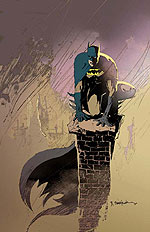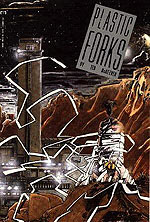Option Click. Delete. Cannot Undo. | |

| I'm no comics expert - so if you are stop reading now, you'll only get annoyed - but every so often I find myself wandering into one of those dim, corridor-like shops full of monster toys, sad goblin posters and Buffy memorabilia. Yesterday was one such day: I found myself down the other end of Exeter, where I haven't been for ages, with my daughter asleep in the buggy, and my eye caught the window display of the comic shop. The paper edition of Arkham Asylum was there, but next to it was an intriguing cover for Batman. Scarface. a psychodrama. It looked like the work of Bill Sienkiewicz. A closer look revealed his name sideways down the edge. I pushed open the creaking door and went in, prepared to delve. Now, let me explain. I tend to occasionally come to comics because I like the art in them. The general run of superheros and their enemies leave me cold, so do the TV delights of Buffy et al, and the cartoon world of the Simpsons and their ilk. I have a few graphic novels on the shelf, and less than a dozen individual comics bought, on trips like yesterday's, for the art: a double page spread of a city; a curvaceous retro 50s rocket; a David Sylvian clone on a tightrope in Moonshadow. Next to Jon Muth's Dracula and Dave McKean's Signal to Noise [more about McKean later] sit my Ralph Steadman, Edward Gorey and Steve Bell cartoon books. And favourites of all my comic/cartoon collection the four-part graphic novels that were Stray Toasters and Plastic Forks, two confused and confusing postmodern works of genius that prove comics can be intelligent, intriguing and interesting - both in their storylines and their visual presentation. |

| Stray Toasters was what got me into comics, and I spent months looking for future Bill Sienkiewicz work, only to find that he did endless covers, but that when you opened said covers the actual comic inside was by someone else, and was dull, mundane and childish; not to mention badly drawn. So I kind of went off the idea. Ted McKeever, who did Plastic Forks, I never came across again; still haven't. Anyway, where was I. Oh yes, Scarface. Now here on the desk as part of yesterday's haul. What can I say? 'Psychodrama' is a bit much for a basic trawl through the ventriloquist's dummy nightmare most of us know; this is a simplistic retelling of that story, with a bit of Batman thrown in. Oh, and Joker, too. I don't know enough about Batman mythology to know if I'm missing some important point about the story, but once again, the Sienkiewicz cover is the best thing in this comic. At least it's 1 of 1, so I have the full story. |

| Much better is Sam and Twitch, which I bought four editions of. The drawings in here are good, though not as good as the blurred, moody covers, and the storyline witty and surprising. Sam and Twitch are private detectives trawling through New York, which gets a good look in as background, and I like the whole cynical smartarse tone of the story, though, of course, I've ended up with the last three issues of one story, and a single issue from a new plot. But the framework is slick, the drawing inventive and I'm tempted to order the complete thing on the net as I see Amazon say it's publication is imminent. Best of the bunch is the graphic novel Tell Me, Dark, a horror story set in and below London. Tangents readers will know all about my city-fixation: that and the dreamy, textural soft-focus art soon persuaded me to purchase this. It manages to combine Baudelaire quotes, sex, love, the subterranean and demonology with liberal views of the dark corners of London - many recognisable - into an intriguing tale with a nice final twist, where not all is as it seems. It almost persuades me that there is life in the comic world after all. Almost: for elsewhere I found com-x's Issue #Zero, a sampler featuring original specially-drawn self-contained new comics by the best of British... blah blah blah. A quick flick in the shop, and the desire to find something new, and I bought it. Closer perusal at home means that even I, non-expert comic reader, can recognise Heavy Metal magazine rip-offs like 'Heavy Plant' [nicely drawn though... especially the gouache work on the intro spread]. And why does the world need another big-breasted violent woman superhero[ine] like 'Bazooka Jules'? I mean, come on, the inherent sexism and masturbatory fantasy that produces Lara Croft is bad enough; Bazzoka Jules [fnar fnar fnar] is simply sad - an adolescent anatomical disaster combined with the unsubtle violence of late 1960s Commando magazine. If this is the future of British comics then rag-mags are the new literature. Sad, sad, sad. |

| Better, and also home-grown [in this case literally - the artist/author is from Exeter] is Shaky Kane's The Dinosaurs Are Coming! which combines brilliant satire on Elvis and 'Pinheads' with some fanzine interviews stuff about Exeter hardcore bands. The childlike style and crazy jokey style [visual and literary] don't always come off, but it's certainly better than the com-x stuff. Really what I need, I guess, is a book of covers by Bill Sienkiewicz and chums, without all the storyline. Dave McKean, of course, got that with a brilliant collection of his covers for The Sandman, which I never got to grips with. No, really, I tried and tried - the inside comic art never matched the style of the cover, the stories weren't interesting, original or complex; whatever, I just didn't get into it. But to find the collected cover art book last year was a joy - McKean is a brilliant artist, combining digital processing with collage, cartoons, montage, illustration and photography. So without hesitation I picked up a new book of photographs by him, Option Click, which I later wished I hadn't. Some of the work is fine, no doubt about it, particularly a great portrait of John Cale, where his head and shoulders protrude from a kind of doll's house window surrounded by fairy lights [no, really, it's excellent], and portait of Iain Sinclair, textured with language. But elsewhere the collage/montage is just clumsy and obvious: it's clear what's been stuck on where, how the photo of the Venice canal has been turned upside down and then a little girl added to what was the reflection of the window. The whole feel of the book is slightly portentous, and contains gobbledygook prose artfully typeset opposite the photos. McKean explains that this has been produced by some computer programme which 'allows disparate texts to be mixed together, creating oddly profound, yet meaningless prose'. And in the end that's what the photos feel like, too. Bits mixed together for some personal reason that in the end we aren't privy too and doesn't seem very interesting. Private obsessions and projects often aren't. It's this sense of disappointment after the event, the lack of books or magazines that bear reading and scrutiny at home, that continues to put me off the world of comic shops. I'm sure hundreds of readers can tell me what I'm missing [please don't] but in the end I can't be arsed to flick through the racks any more. This confusing subculture, which managed to combine so much stuff - Star Trek, Buffy, Simpsons, gothic horror, detective stories, sci-fi, violence, fantasy and war - has me beat. The likes of Tell Me, Dark are all too rare; the likes of Stray Toasters and Plastic Forks too infrequent an occurrence - a momentary, intelligent blip in the dark - to persuade me that I'm missing anything. © Rupert Loydell 2001 |